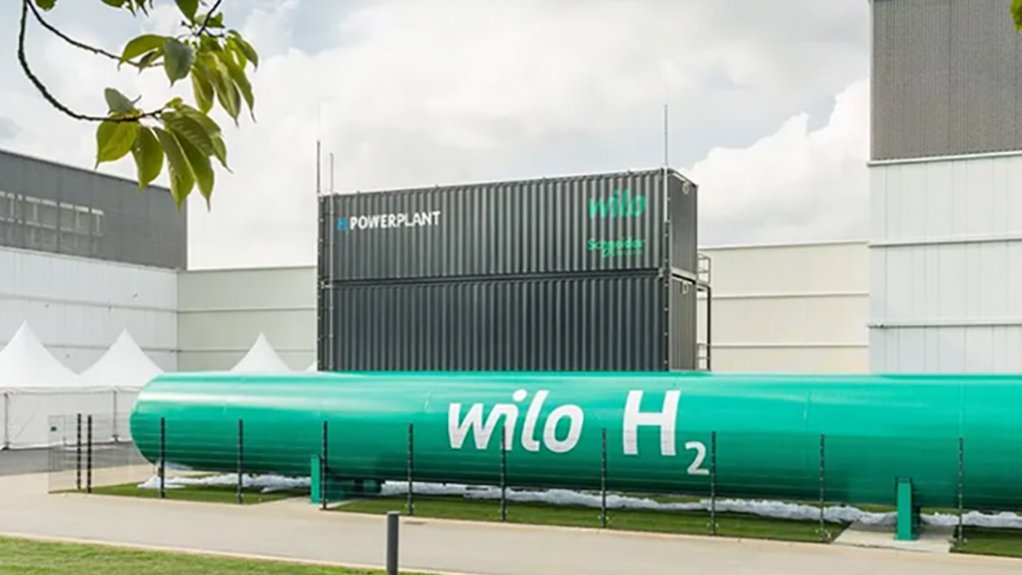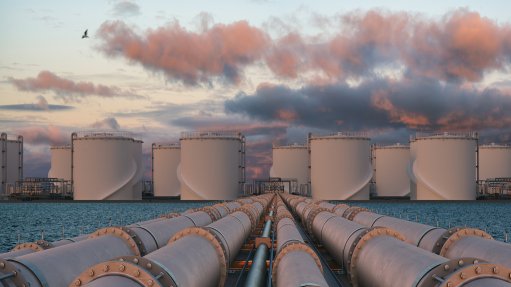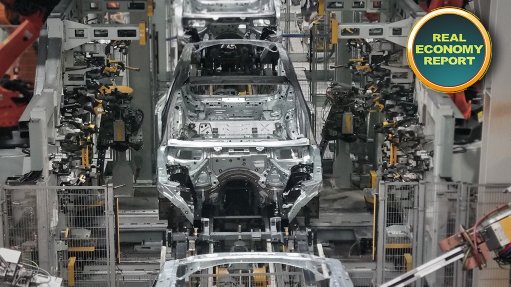Storing hydrogen is best way to store green energy, Heraeus Precious Metals points out



Heraeus VP Philipp Walter interviewed by Mining Weekly's Martin Creamer. Video: Darlene Creamer.
Wilo pump manufacturing plant.
Members of the hydrogen talks panel.
JOHANNESBURG (miningweekly.com) – Wilo, a global name in pump manufacturing, now has solar panels on the roofs of all of its buildings to enable green hydrogen generation through electrolysis.
The stored hydrogen is then used as needed by passing it through platinum-catalysed fuel cells, which turn the hydrogen passed through them into green electricity to run Wilo’s operations in Germany.
The H2Powerplant is offered in four sizes, with the capacity to produce power equivalent to the yearly consumption of three, five, or 20 households.
Fuel Cell Works reports that this technological approach is enabling companies to accelerate the migration to clean energy from existing infrastructure without having to start from scratch.
Hydrogen, which can be stored for prolonged periods, is now being increasingly recognised as the superior energy storage option amid supply chains of raw materials such as platinum group metals (PGMs) also being increasingly elevated to the rank of decarbonising champions.
Key contributors are platinum-based proton exchange membrane (PEM) fuel cells, amid green hydrogen generation and demand rising significantly in particularly China.
What is seen as urgent is that the hydrogen fuel cells industry uplifts itself fast to enable it to progress more rapidly into the mass market.
The peaks and valleys of renewable-energy supply are best balanced out by stored hydrogen or hydrogen compounds, Heraeus Precious Metals executive VP business line systems Dr Philipp Walter spelt out during a Zoom interview with Mining Weekly. (Also watch attached Creamer Media video.)
“I believe every time it comes to dealing with hydrogen, platinum group metals have an advantage,” Walter added.
Heraeus’ virtual hydrogen talks involved inputs from Ulm and TU Wein University professor Dr Christian Mohrdieck, Freudenberg e-Power Systems Clean Energy Consulting’s Dr Manfred Stefener and UFI Hydrogen’s Marco Lazzaroni amid an important spotlight being shone on the extent to which platinum-catalysed fuel cells will drive future hydrogen demand.
The Germany-based precious metal and technology company Heraeus has had a long-standing association with South Africa, where its local entities include a marketing and sales office in Boksburg and a platinum group metals chemical compounds production and refinery site in Gqeberha.
Mining Weekly can report that the group’s sales of PGM-based electric catalysts for hydrogen generation, which peaked in 2023, are back up again in 2025 owing to increased demand.
A hydrogen price of €5/kg to €6/kg was regarded as a tipping point by the panel, which sees no way around hydrogen owing to its versatile usage and water being the feedstock raw material for making hydrogen, which can be stored for a day, a week, a month, a year or more.
The amount of water needed for green hydrogen production is similar to that required for grey hydrogen, averaging about 10 to 19 litres per kilogram.
It's important to understand that the market for green hydrogen is already there because the world is consuming 100-million tons a year of hydrogen that are “polluting like hell”, the French company Lhyfe has emphasised.
Lhyfe founder and CEO Matthieu Guesné is adamant that “there's nothing that’s easier to do when decarbonising a customer, a plant, an industrial player, than switching from grey hydrogen to green hydrogen”, so that's what this publicly listed company is doing.
Mining Weekly: Why is hydrogen seen as the superior energy storage option?
Walter: If you have renewable energy, you have ups and downs, peaks and valleys in terms of supply, and the best way to store energy, in this respect, is hydrogen, or compounds of hydrogen. You need chemical energy storage for these kinds of intermittent energy sources.
What are the various mobility applications that need to be included?
Fuel cells are not only used in mobility applications. They are also used in stationary applications. But the one major demand driver might be the mobility applications, and what's included there is, first of all, heavy-duty vehicles. We have to consider maritime applications, ships and what have you, aviation and last but not least, also passenger cars. But this is not so straightforward right now, owing to a strong incumbent, which are basically the battery electric vehicles.
Why is membrane electrode assembly, or MEA, technology seen as being pivotal?
When we are talking about PEM fuel cells, and that's the majority of the fuel cells out there – and especially those in mobility applications – the durability of the MEA is important, because otherwise your fuel cell basically breaks down, which is something you want to prevent, and you need a certain lifetime for all these mobility applications as well as stationary applications.
Are we talking about green hydrogen?
Currently, predominantly grey hydrogen is being consumed and used, but green hydrogen will play an important role in the future. This is the current understanding. The main applications right now are chemicals and refining. That's basically where a lot of hydrogen is consumed or used. But in the future, there will be additional applications due to the various decarbonisation efforts, namely in heavy-duty road transport, iron and steel, aviation and maritime, heating and power supply. These will all have a certain role, to what extent remains to be seen. The hydrogen fuel cells industry still has to do some homework before they are really in the mass market.
Which continents are leading in hydrogen?
Europe still has some advantages in some hydrogen technologies. Asia, in particular China, also has some advantages in some hydrogen technologies. The US is a little bit unclear due to the current political climate. From a demand perspective, China is certainly on the way up when it comes to the demand or the generation of green hydrogen.
Why is the supply chain for hydrogen so crucial?
The supply chain covers two aspects. A hydrogen strategy also requires a raw materials strategy. You need to have a certain supply chain and raw materials such as platinum group metals. The supply chain of raw materials like platinum group metals is crucial for the hydrogen economy and for the actual hydrogen molecule, infrastructure is important, especially when considering mobility applications.
What homework must be done to bring down the cost of hydrogen and is there sufficient openness about hydrogen fuel cell technology?
On the one hand, the cost of hydrogen has to come down to a level of maybe €5/kg to €6/kg. This is probably what was considered in this panel last week as a tipping point. Hydrogen infrastructure and hydrogen supply needs to be established. You need a certain hydrogen generation and also the offtake, and then the technologies need to be proven to be reliable, and the reputation needs to be corrected, because some of the timelines for the huge hydrogen projects have been postponed and projects must be made to happen. On top of that is the need for hydrogen education, and regarding technologies, what I’ve noted in Europe is that there are so many restrictions and there's always some steering towards certain technologies. Let's stay technology open and let's use all the technologies to establish a hydrogen industry and to make decarbonisation happen.
To what extent are hydrogen fuel cells also suitable for non-mobility applications?
When you are remote or when you want to ensure some energy supply, hydrogen fuel cells are an option. For example, when you have a data centre where you have a huge energy demand and where frequent breakdown of energy has to be avoided, fuel cells are coming into play increasingly for backup power supply.
What makes you certain that hydrogen will find its way well as a fuel for mobility?
Assuming decarbonisation has to happen, I think there’s no way around hydrogen due to its versatile usage and the abundance of water, which is the feedstock, the raw material for making hydrogen. In combination with renewable energy, I think green hydrogen is something that will come. It will perhaps take more time than originally anticipated, but I think there is no way around it. Otherwise, decarbonisation will not work. We have to decarbonise also the hard-to-abate sectors.
INVESTMENT IN DEMAND NEEDED
Many projects are under way involving the installation of electrolysis capacity for green hydrogen and also blue hydrogen.
“But what's also needed is the demand for hydrogen. We have to invest more also to bring up the demand for hydrogen, in particular, green hydrogen. Fuel cells will be one driver in mobility as well as stationary applications,” Walter emphasised.
CHEMICALS INDUSTRY MUST DECARBONISE
The chemicals industry stands at a critical crossroads, the PwC stated in a note for the Manufacturing Indaba. Responsible for creating the fundamental building blocks that make modern life possible – from cosmetics and fertilisers to pharmaceuticals and plastics – this sector now faces its greatest challenge yet: dramatically reducing its massive carbon footprint while meeting growing global demand.
As the second-highest industrial CO2 emitter behind only steel production, the chemicals industry's transformation will be pivotal in achieving global climate goals. New research from the University of Technology Sydney's Institute for Sustainable Futures, in collaboration with PwC Germany, reveals promising pathways toward this essential transition.
The study focuses on the industry's core: seven base chemicals—methanol, ammonia, benzene, toluene, xylene, ethylene and propylene—which collectively account for a staggering 74% of the sector's energy consumption. These fundamental chemicals form the foundation of some 70 000 products that permeate daily lives. By 2050, their production volumes are projected to surge nearly 70% from 2020 levels, reaching 1.255-billion tonnes and driving an 81% increase in energy requirements.
What makes defossilising chemicals particularly challenging is the industry's dual dependence on fossil fuels. Unlike other sectors that primarily use fossil fuels for energy, the chemicals industry also relies on them as raw material feedstocks, comprising between 48% and 85% of overall use. Currently, some 95% of these feedstocks derive from fossil sources, with the seven key chemicals responsible for 52% of the sector's total CO2 emissions.
The path forward demands nothing short of reinvention. To align with the 2015 Paris Agreement goals, emissions from these seven chemicals must be reduced by 85% from 2020 levels by mid- century, with energy-related emissions reaching zero. This transformation requires transitioning to low-carbon feedstocks like biomass and green molecules, deploying innovative technologies, embracing circular manufacturing practices and powering facilities with renewable energy.
Green hydrogen emerges as a particularly promising platform, capable of producing a diverse range of chemicals. Additionally, CO2 captured from renewable sources will become an essential commodity for non-energy chemical production processes, PwC stated.
The financial requirements for this transition are substantial but necessary. The industry will need cumulative investments between $1.5-trrillion and $3.3-trillion through 2050 across three critical infrastructure areas: constructing new facilities and retrofitting existing ones, transforming heat supply systems primarily through electrification and developing renewable feedstock supply chains.
“Different chemical processes require varying levels of investment. Ammonia production needs $200-bilion to $970-billion, primarily for renewable hydrogen infrastructure. Methanol requires $150-billion to $440-billion for biomethanol and e-methanol production facilities. Olefins demand the largest share at $900-billion to $1.5-trillion, mainly for electrified steam crackers. Aromatics will require $220-billion to $370-billion for processes including lignin breakdown and methanol-to-aromatics conversion,” PwC calculated.
The urgency for immediate action cannot be overstated. With project implementation timelines spanning five to ten years and operational lifespans measured in decades, delays now will have profound consequences. The One Earth Climate Model calculates that postponing implementation by just five years would generate an additional six gigatonnes of CO2 emissions.
“The economic viability of this transformation is significant. These investments would not only bring environmental benefits; they could also be a significant driver for continuous growth and employment around the world. Global capital spending in the chemicals industry was €267-billion ($290-billion) in 2022. While the required investment through 2050 is substantial, it represents a strategic opportunity. Companies that move early to provide green materials will gain a competitive advantage as demand increases across sectors committed to their own net-zero journeys. The chemicals industry has a particularly advantageous position in this transition, as its products are required in almost every aspect of modern life,” PwC added.
Article Enquiry
Email Article
Save Article
Feedback
To advertise email advertising@creamermedia.co.za or click here
Comments
Press Office
Announcements
What's On
Subscribe to improve your user experience...
Option 1 (equivalent of R125 a month):
Receive a weekly copy of Creamer Media's Engineering News & Mining Weekly magazine
(print copy for those in South Africa and e-magazine for those outside of South Africa)
Receive daily email newsletters
Access to full search results
Access archive of magazine back copies
Access to Projects in Progress
Access to ONE Research Report of your choice in PDF format
Option 2 (equivalent of R375 a month):
All benefits from Option 1
PLUS
Access to Creamer Media's Research Channel Africa for ALL Research Reports, in PDF format, on various industrial and mining sectors
including Electricity; Water; Energy Transition; Hydrogen; Roads, Rail and Ports; Coal; Gold; Platinum; Battery Metals; etc.
Already a subscriber?
Forgotten your password?
Receive weekly copy of Creamer Media's Engineering News & Mining Weekly magazine (print copy for those in South Africa and e-magazine for those outside of South Africa)
➕
Recieve daily email newsletters
➕
Access to full search results
➕
Access archive of magazine back copies
➕
Access to Projects in Progress
➕
Access to ONE Research Report of your choice in PDF format
RESEARCH CHANNEL AFRICA
R4500 (equivalent of R375 a month)
SUBSCRIBEAll benefits from Option 1
➕
Access to Creamer Media's Research Channel Africa for ALL Research Reports on various industrial and mining sectors, in PDF format, including on:
Electricity
➕
Water
➕
Energy Transition
➕
Hydrogen
➕
Roads, Rail and Ports
➕
Coal
➕
Gold
➕
Platinum
➕
Battery Metals
➕
etc.
Receive all benefits from Option 1 or Option 2 delivered to numerous people at your company
➕
Multiple User names and Passwords for simultaneous log-ins
➕
Intranet integration access to all in your organisation





















